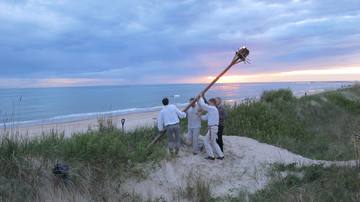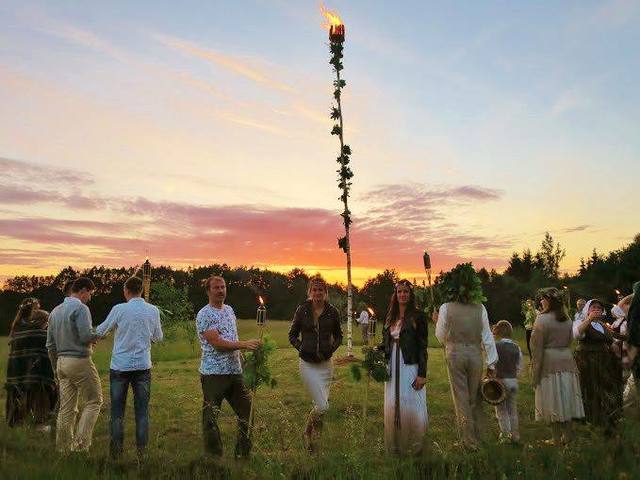Summer Solstice traditions
The Summer Solstice is the merriest Latvian holiday of the year, and people await it with much anticipation. Long before Jāņi, we hear folk songs with the refrain "līgo." This singing is widespread, with people starting to celebrate Jāņi while they do their housework and gussy up their homes for the celebration.
People who await the Solstice have to do lots of work in advance of the celebration, lest visitors start to sing naughty songs about the laziness of the homeowner.
Picking Solstice grasses, weaving crowns and decorating farms
The beginning of the Solstice is Grass Day, with people decorating their farms, weaving crowns and picking Summer Solstice grasses. That's the origin on the name of Grass Day. People decorate their buildings, gates, doors, windows, roofs, rooms, tables, chairs and tools. The grasses are said to ensure fertility and a blessing, ensuring success, health and welfare. That is why the children of Jāņi present people, livestock and buildings with Solstice grasses as a way of offering the best wishes. Latvians believe that grasses that are picked on Grass Day and during the Solstice have magical powers, because they have been picked at a time when nature is most active. The decorations include oak branches and crowns, garlands, birch branches, leaves, flowers and garlands of grasses. Doors and yards are usually decorated with birch and oak branches, which defends the home against evil, witches, wizards and envious people who are particularly active during the holiday in terms of trying to harm farms, fields, homes and people. To prevent this, people put mountain ash branches on their doors and other places on the farm that they wish to protect. Mountain ash protects people against evil.
The berries have a cross at their ends, and this protects us. Other sharp plants are used to prevent evil, including thistles, apple tree branches, scythes, needles, harrows and nettles.
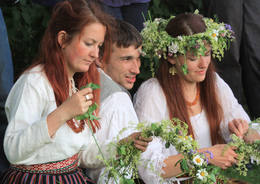
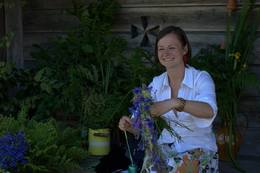
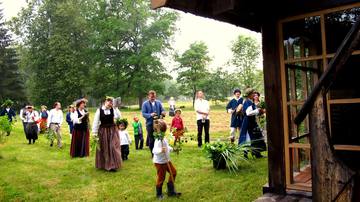
Preparing a meal
As is the case during holidays, celebrants of the Summer Solstice gather at the table, featuring many dishes that are of symbolic importance. Work on preparing these dishes begins before the Solstice so that they are ready for the celebration. The main element is Summer Solstice cheese, which is round or with nine corners. Round and yellow, the cheese symbolises the sun. The appearance, colour and taste of the cheese have remained unchanged for many centuries.
The beverage for the Solstice is beer, which symbolises life and the juices of life, because it is prepared from living grains. Beer also symbolises the merger between material and spiritual aspects of life in that it has airy foam. Children drink mead. Also on the table is honey, which is produced by bees and is a gift from God. Honey is so very thorough! Alongside it there must be bread, pierogi and pastries, because grain that is used to mill flour is a symbol of life and strength.
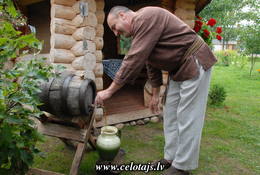
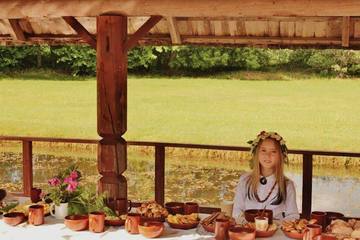
The fire of Summer Solstice
Fire is an inviolable part of Summer Solstice celebrations. The campfire is lit at sunset and kept burning until sunrise so that the presence of light is not interrupted. People gather at nearly every farm around a campfire, raising a pole on top of which there is a burning barrel. This symbolises the rise of the Sun on the hills of the heavens, as well as the complete victory of light over the darkness.
People around the campfire try to spend all night awake, the idea being that someone who sleeps during Summer Solstice Eve will be sleeping all summer long. The sunrise is greeted with songs and light thoughts. This means saying goodbye to Jānis, inviting him to come back next year.
